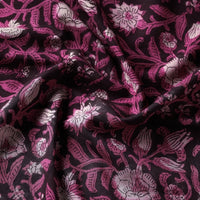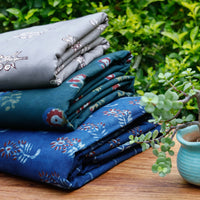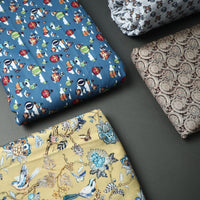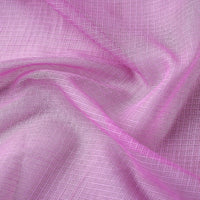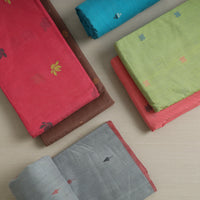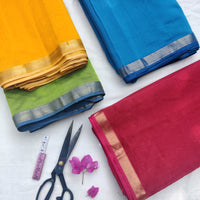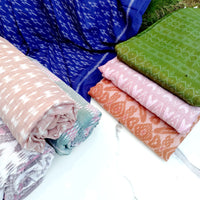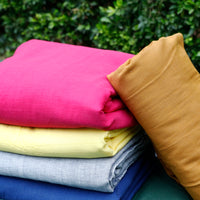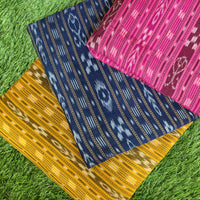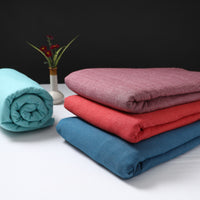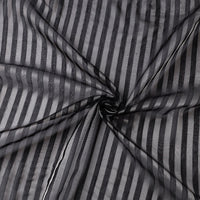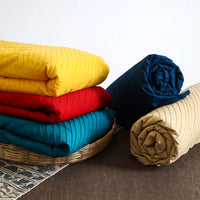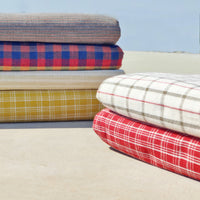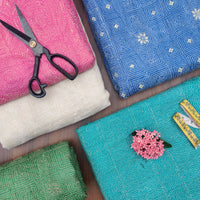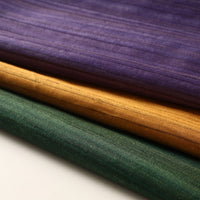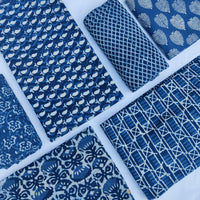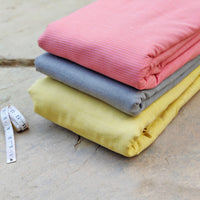The Timeless Legacy of Tussar Silk: Weaving Tradition, Community, and Craftsmanship
Introduction to Tussar Silk
Tussar silk, also known as Kosa silk, is a treasure of Indian heritage, revered for its rich texture, natural golden hue, and enduring elegance. This exquisite fabric is handwoven by skilled artisans who have inherited the craft through generations. Originating from the wild forests of India, primarily in the states of Jharkhand, Chhattisgarh, Odisha, and West Bengal, Tussar silk is not just a fabric; it is a symbol of tradition, sustainability, and the intricate artistry of rural India.
At iTokri, we honor the craft of Tussar silk by offering a curated collection that connects global consumers with the heart and soul of Indian artisans. Each piece of Tussar silk in our collection tells a story of heritage, community, and sustainable craftsmanship. By choosing iTokri, you are not just purchasing a product; you are supporting a legacy that preserves the cultural fabric of India.
The Origins and Cultural Significance of Tussar Silk
The story of Tussar silk begins in the lush forests of India, where wild silkworms, particularly the Antheraea mylitta, are reared. Unlike the domesticated Bombyx mori silkworms that produce Mulberry silk, these wild silkworms feed on the leaves of trees such as Asan and Arjun. The result is a silk that is coarser and stronger, with a naturally rich texture and an unmatched golden sheen.
The art of weaving Tussar silk dates back to ancient times, with references found in Vedic scriptures and Indian epics like the Mahabharata. Historically, Tussar silk was worn by royalty and was an integral part of religious and ceremonial attire. The fabric’s natural warmth and luster made it highly prized among kings, queens, and noblemen, symbolizing both wealth and piety.
Today, the significance of Tussar silk transcends fashion. It represents the resilience of indigenous communities, particularly in regions like Bhagalpur (Bihar), Malda (West Bengal), and the tribal areas of Jharkhand and Chhattisgarh, where the art of Tussar weaving is a vital source of livelihood. By purchasing Tussar silk, consumers are not only acquiring a piece of history but are also contributing to the sustainability of these communities.
The People Behind Tussar Silk: Guardians of a Living Tradition
The production of Tussar silk is a labor-intensive process that involves several stages, each requiring a high level of skill and precision. From sericulture to weaving, every step is a testament to the dedication of the artisans who have perfected this craft over centuries.
Sericulture: The journey begins in the forests, where tribals and rural families rear wild silkworms on the trees. Unlike cultivated silk, where the worms are fed in controlled environments, Tussar silkworms are left in the wild, making the process more sustainable and eco-friendly. The rearing of these silkworms is deeply intertwined with the local ecosystem, promoting biodiversity and forest conservation.
Reeling and Spinning: Once the cocoons are harvested, they are carefully boiled to extract the silk threads. This process, known as reeling, is often carried out by women in the villages. The threads are then spun into yarns, a task that requires immense skill to ensure the silk retains its natural sheen and strength.
Weaving: The spun yarns are then handed over to master weavers, who work on traditional handlooms to create the final fabric. Each piece of Tussar silk is a work of art, with intricate patterns and motifs that reflect the cultural heritage of the region. The weaving techniques vary from one community to another, with some regions known for their elaborate Jamdani patterns, while others specialize in simple, elegant plain weaves.
Regional Variations and Unique Characteristics
One of the most fascinating aspects of Tussar silk is its regional diversity. Each area where Tussar silk is produced has developed its own distinct style, influenced by local traditions, natural resources, and the creativity of its artisans.
Bhagalpur, Bihar: Known as the "Silk City of India," Bhagalpur is renowned for its Tussar silk sarees and dupattas. The weavers here have mastered the art of blending Tussar silk with other fabrics like cotton and linen, creating unique textures and patterns that are highly sought after in both domestic and international markets.
Jharkhand and Chhattisgarh: These states are the heartland of tribal Tussar silk production. The weavers here often incorporate natural dyes made from forest produce, giving the silk a rustic, earthy appeal. The motifs are inspired by nature, featuring elements like trees, flowers, and animals, which hold spiritual significance in tribal culture.
West Bengal: Malda, in particular, is famous for its fine Tussar silk, often woven with intricate Jamdani patterns. The silk from this region is softer and more refined, making it ideal for luxurious sarees and stoles.
Odisha: The weavers of Odisha are known for their vibrant Tussar silk fabrics, often adorned with traditional Ikat patterns. The process of Ikat involves dyeing the yarns before they are woven, creating complex, colorful designs that are unique to this region.
Human Interest Stories: The Lives and Struggles of Tussar Artisans
Behind every piece of Tussar silk lies the story of an artisan, whose hands have meticulously crafted the fabric that weaves together tradition and livelihood. These stories are not just about craft; they are about resilience, creativity, and the struggle to preserve a way of life in the face of modernization and economic challenges.
Take, for example, the story of Lakshmi Devi, a master weaver from Bhagalpur, Bihar. Born into a family of weavers, Lakshmi learned the art of Tussar weaving from her mother and grandmother. Despite the decline in demand for handwoven fabrics due to the rise of power looms, Lakshmi has continued to practice her craft with unwavering dedication. Her sarees, known for their intricate Jamdani work, have won accolades at various handicraft exhibitions across India. Lakshmi’s story is one of many, highlighting the role of women in preserving traditional crafts and contributing to their families’ livelihoods.
In the tribal areas of Jharkhand, the story of Ramesh Kumar, a sericulturist, is equally inspiring. Ramesh belongs to a community that has been rearing Tussar silkworms for generations. With the support of local NGOs and government initiatives, Ramesh has been able to expand his small-scale sericulture business, providing employment to other members of his village. His commitment to sustainable practices, such as organic rearing methods and natural dyeing, has made his Tussar silk highly valued among eco-conscious consumers.
The Role of iTokri in Supporting Tussar Silk Artisans
At iTokri, we are deeply committed to supporting the artisans behind Tussar silk and other traditional crafts. Our platform is more than just a marketplace; it is a space where the rich cultural heritage of India is celebrated and preserved.
Discover iTokri: India’s Premier Artisan Craft Platform iTokri stands out in the global marketplace by offering authentic, handcrafted products directly sourced from over 500 artisan groups across India. Our Tussar silk collection is a testament to our dedication to preserving traditional crafts and promoting sustainable practices. Each purchase at iTokri supports the livelihoods of artisans like Lakshmi and Ramesh, ensuring that their skills are passed down to future generations.
Why Choose iTokri?
-
Authenticity and Trust: We guarantee that every piece of Tussar silk you purchase from iTokri is ethically sourced and handcrafted with care. Our commitment to authenticity ensures that you receive a product of the highest quality, while also supporting the communities that create them.
-
Cultural Preservation: iTokri is dedicated to keeping traditional crafts alive. Our Tussar silk collection celebrates the diversity of this fabric, showcasing the unique styles and techniques of different regions across India.
-
Sustainability at Core: We believe in sustainable practices that respect the environment and the artisans who work within it. From using recycled materials in our packaging to promoting eco-friendly crafts, iTokri is committed to making a positive impact on the planet.
-
Community and Engagement: At iTokri, we go beyond transactions to foster a community of craft lovers and artisans. Through storytelling, we share the unique stories of the people behind the crafts, bringing you closer to the rich traditions of India. We also host events and workshops that celebrate the art of Tussar silk, allowing you to engage directly with the artisans.
-
Global Reach, Local Touch: While iTokri serves a global audience, our approach remains deeply rooted in local practices. We offer a platform where traditional techniques meet modern aesthetics, ensuring that each piece of Tussar silk is both timeless and relevant.
Conclusion: Joining the iTokri Family
When you shop at iTokri, you are not just buying a piece of fabric; you are becoming part of a movement that values beauty, craftsmanship, and sustainability. Our Tussar silk collection is a celebration of the rich cultural heritage of India and the artisans who bring it to life. Each item tells a story of skill, tradition, and a passion for sustainable art.
Experience the warmth of Indian hospitality and the luxury of genuine handcrafted products at iTokri. Join us in supporting the artisans who have dedicated their lives to preserving the ancient art of Tussar silk weaving. Together, we can ensure that this legacy continues to thrive for generations to come.
FAQ: Tussar Silk Fabrics Collection
1. What is Tussar Silk and how is it different from other types of silk?
Tussar Silk, also known as Kosa Silk, is a type of silk known for its rich texture and natural gold sheen. Unlike Mulberry Silk, which is smooth and uniform, Tussar Silk has a more textured feel due to its shorter fibers. It’s produced by the silkworm Antheraea mylitta, which feeds on wild forest trees, making it an eco-friendly option. Tussar Silk is less lustrous than other silks but is highly valued for its natural, earthy appearance and durability
.
2. Where is Tussar Silk produced in India?
Tussar Silk is primarily produced in the states of Jharkhand, Bihar, Chhattisgarh, and West Bengal. These regions are rich in the forest trees that the Tussar silkworms feed on, such as Arjun, Asan, and Sal trees. The craft of weaving Tussar Silk is deeply embedded in the culture of these areas, with artisans passing down the skill through generations.
3. What are the benefits of wearing Tussar Silk?
Tussar Silk is highly breathable and comfortable, making it ideal for warm climates. It has a natural, elegant drape and its gold sheen adds a touch of luxury to any outfit. Tussar Silk is also durable and becomes softer with each wash. Additionally, since it’s less processed than other silks, it retains its natural texture and is often chosen by those who appreciate organic and sustainable fabrics.
4. How should I care for my Tussar Silk fabric?
Caring for Tussar Silk is relatively easy. Hand wash the fabric in cold water using a mild detergent, and avoid wringing or twisting the fabric. It’s best to dry it in the shade to preserve its natural color and sheen. If ironing is needed, use a low-heat setting on the reverse side. For long-term storage, keep it in a breathable cotton bag to avoid moisture buildup.
5. What makes Tussar Silk eco-friendly?
Tussar Silk is considered eco-friendly because the silkworms are reared in their natural habitat and feed on wild forest trees, which reduces the need for artificial cultivation. The production process is less intensive compared to other silks, and many Tussar Silk fabrics are dyed using natural dyes. Additionally, the weaving process supports rural artisans and promotes sustainable livelihoods.
6. Can Tussar Silk be worn year-round?
Yes, Tussar Silk is versatile enough to be worn throughout the year. Its breathable nature makes it perfect for summer, while its ability to retain warmth makes it suitable for cooler months as well. The fabric’s natural texture and drape make it an excellent choice for both casual and formal occasions.
7. How can I identify authentic Tussar Silk?
Authentic Tussar Silk has a distinct texture with a slightly rougher feel compared to other silks. The fabric often has an uneven surface due to the shorter fibers. When held up to the light, Tussar Silk should have a natural gold or coppery sheen. Another way to test authenticity is by burning a small thread of the fabric; genuine silk burns slowly with a smell similar to burning hair, leaving behind ash instead of hard residue.
8. Is Tussar Silk available in different colors and patterns?
Absolutely! Tussar Silk comes in a wide variety of colors and patterns, from traditional hand-block prints to modern designs. The fabric takes well to dyes, both natural and synthetic, resulting in a rich array of hues. Artisans often use traditional methods like hand painting and embroidery to create unique and intricate patterns on Tussar Silk.
9. How does Tussar Silk compare in price to other types of silk?
Tussar Silk is generally more affordable than premium silks like Mulberry Silk, but its price can vary depending on factors like the intricacy of the weave, the type of dye used, and any additional embellishments. Despite being more affordable, Tussar Silk offers great value due to its durability, unique texture, and cultural significance.
10. Why should I choose Tussar Silk over other fabrics?
Choosing Tussar Silk means embracing a fabric with rich cultural heritage and natural beauty. It supports sustainable practices and the livelihoods of rural artisans. The fabric’s unique texture, natural sheen, and versatility make it a standout choice for anyone looking to add timeless elegance to their wardrobe. Plus, its eco-friendly production
टसर सिल्क का सदाबहार धरोहर: परंपरा, समुदाय, और शिल्पकला का एक अद्वितीय संगम
परिचय: टसर सिल्क, जिसे कोसा सिल्क के नाम से भी जाना जाता है, भारतीय धरोहर का एक अनमोल खजाना है। इसकी समृद्ध बनावट, प्राकृतिक सुनहरे रंग और अनंत सुंदरता के लिए इसे अत्यधिक सराहा जाता है। यह विशिष्ट कपड़ा कुशल कारीगरों द्वारा हाथ से बुना जाता है, जिन्होंने पीढ़ियों से इस कला को संरक्षित किया है। झारखंड, छत्तीसगढ़, ओडिशा और पश्चिम बंगाल के वनों से उत्पन्न, टसर सिल्क केवल एक कपड़ा नहीं है; यह भारतीय परंपरा, स्थिरता, और ग्रामीण भारत की जटिल कला का प्रतीक है।
टसर सिल्क का उत्पत्ति और सांस्कृतिक महत्व: टसर सिल्क का सफर भारत के हरे-भरे वनों से शुरू होता है, जहां अनथेरा माइलिटा नामक जंगली रेशम कीटों का पालन होता है। यह रेशम अन्य प्रकार के रेशम से मोटा और मजबूत होता है, जिसमें एक अद्वितीय स्वाभाविक सुनहरी चमक होती है। ऐतिहासिक रूप से, टसर सिल्क का उपयोग राजाओं और रानियों द्वारा किया जाता था और यह धार्मिक और अनुष्ठानिक पोशाक का एक अभिन्न हिस्सा था। आज, टसर सिल्क स्थानीय समुदायों के लिए एक महत्वपूर्ण आजीविका का स्रोत है, विशेष रूप से बिहार, पश्चिम बंगाल, झारखंड और छत्तीसगढ़ के जनजातीय क्षेत्रों में।
कारीगरों की भूमिका: टसर सिल्क का उत्पादन कई चरणों में होता है, जिनमें से प्रत्येक में उच्च स्तर के कौशल और सावधानी की आवश्यकता होती है। रेशम के कीड़ों की पैदावार से लेकर अंतिम कपड़े को बुनने तक, हर चरण में कारीगरों की महत्वपूर्ण भूमिका होती है। यह शिल्प कला सदियों से संरक्षित और प्रचलित है, और यह स्थानीय कारीगरों की आजीविका के लिए महत्वपूर्ण है।
iTokri की भूमिका: iTokri पर, हम टसर सिल्क और अन्य पारंपरिक शिल्पकला के कारीगरों का समर्थन करने के लिए प्रतिबद्ध हैं। हमारे प्लेटफॉर्म पर, आप टसर सिल्क के बेहतरीन संग्रह का आनंद ले सकते हैं, जो भारत की सांस्कृतिक विविधता और कारीगरों के अद्वितीय कौशल का उत्सव है। iTokri से खरीदारी करने का अर्थ है न केवल एक उत्कृष्ट उत्पाद प्राप्त करना, बल्कि उन कारीगरों की भी सहायता करना जो इस प्राचीन कला को जीवित रखे हुए हैं।

















